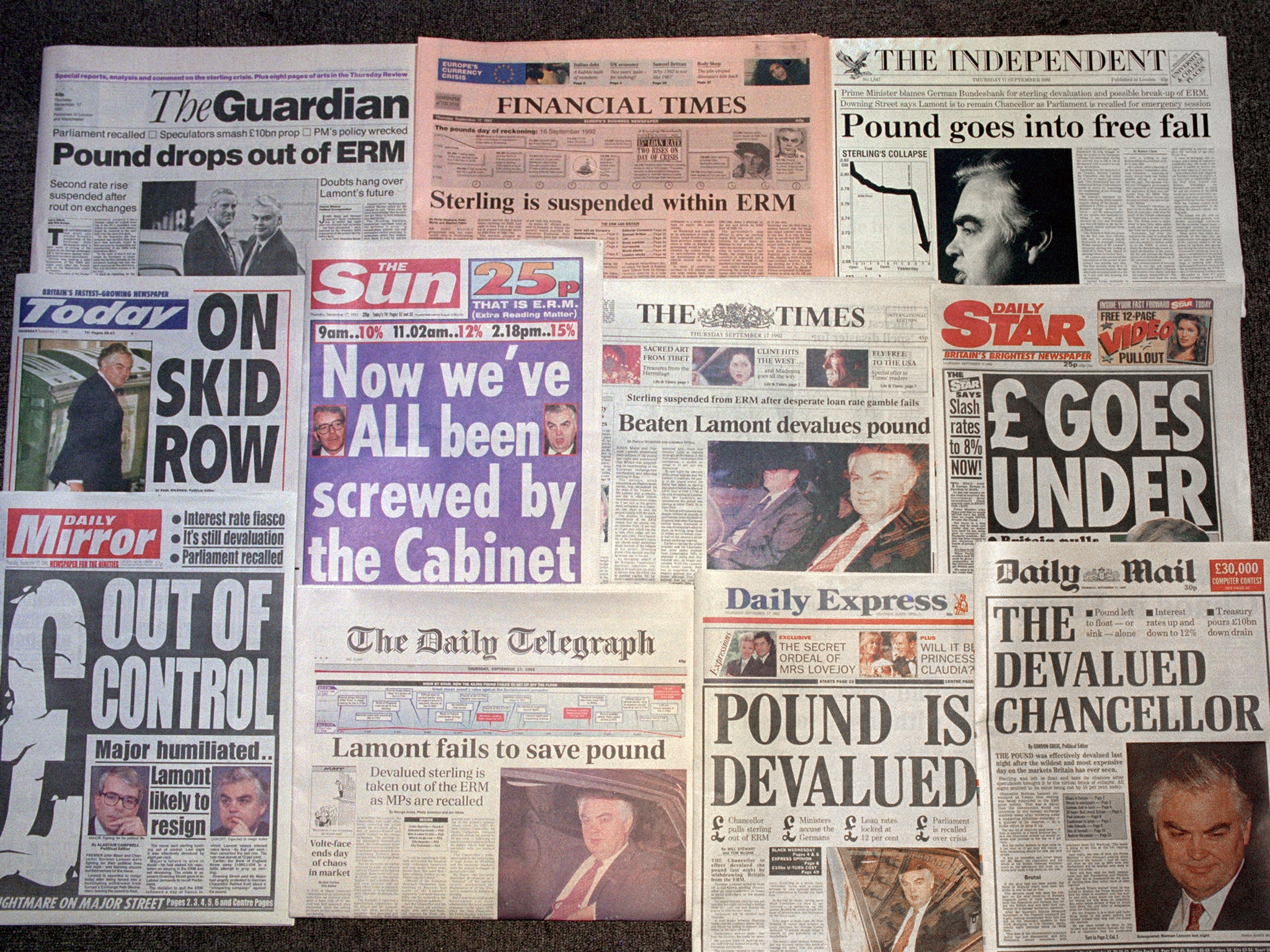The economic story of Brexit started decades before the EU referendum
Joining the ERM was part of the aim, to use John Major's words, to 'place Britain at the heart of Europe'


Let’s step back from the Brexit business – step back 25 years in fact. For it was just over 25 years ago that an event happened that some of us think was the key turning point in the UK’s relationship with Europe, Black Wednesday, when sterling was ejected from the European Exchange Rate Mechanism.
The country had joined the ERM in October 1990, while Margaret Thatcher was still Prime Minister, but the pressure to join came from members of the cabinet, including John Major then the Chancellor. It was part of the aim, to use his words, to “place Britain at the heart of Europe.”
The decision received widespread support, including from The Independent. We carried a leader arguing that not only was this event a welcome political decision, but to link the pound to the deutsche mark would help give economic stability to as well. It was cogent and well-argued, but of course completely wrong (disclosure: I wrote it.)
Less than two years later a wave of short selling led by the speculator George Soros overwhelmed the ability of the Bank of England to support the pound. Soros became “the man who broke the Bank of England”, Norman Lamont, who had become Chancellor when John Major stepped up to the premiership, found his political career blighted, and the Major government never recovered.
I was reminded of all this by a round table discussion this week about a new book, Six Days in September – Black Wednesday, Brexit, and the making of Europe, which tells the tale in vivid detail. The authors, William Keegan, economic journalist, David Marsh, managing director of Official Monetary and Financial Institutions Forum, which published the book, and Richard Roberts, professor at King College London, have all been involved in the story in one way or another. Keegan and Marsh reported on it at the time, and Roberts has studied it as a financial historian.
The six days were from 11 to 16 September 1992. The story of the ERM, however, goes back much further, to 1979, when the experience of a few rather chaotic years of floating currencies encouraged some European countries to link their currencies together. The idea was to use intervention on the exchanges to hold them within set bands on either side of a central rate. In effect currencies were pegged to the strongest one, the deutsche mark. It was a sort of forerunner to the euro. Britain stayed out of it, scarred by its experience of pegged currencies. The pound had been forced to devalue twice since the Second World War, in 1949 and 1967, and in both cases the government had suffered humiliation, and were out of office within three years.
There had been realignments within the ERM but by 1992 there was a new special tension, between a recession in much of the developed world, including the UK, and the post-unification boom in Germany. Germany needed higher interest rates (and a revaluation) to contain the boom, while most other countries needed lower ones (and a devaluation) to lift their economies. Actually the initial pressure on the ERM on the Friday was against the Italian lira, which was devalued. As the days rolled by the pressure shifted to sterling. John Major committed to defending the pound on the Friday, decrying devaluation as a soft option, but by Wednesday Britain had used all its reserves, and some, in a futile effort to do so. In a few hours we had gone from having $20bn to “a significant negative position”, as an official reported.
I can’t go into the detail of the story here, except to note one conversation. A month after Black Wednesday the Queen was in Germany on an official visit. She met Helmut Schlesinger, then head of the Bundesbank, who had given an interview during the crisis that had increased the pressure on the pound by seeming to suggest that it would have to be devalued. She asked him, with her uncanny ability to go to the heart of the matter, “whether speculators can really be so strong?”
He replied: “Yes, Madam, in a system of fixed exchange rates with high differentials in the rate of inflation, they can. They have a high chance, unfortunately.”
When the European authorities transformed the ERM into the euro, they took one side of that message: the only way to eliminate speculation was to bind the currencies together permanently. Countries that had higher inflation would just have to cut that inflation, if necessary cutting wages to do so. If they didn’t, they would be faced with soaring unemployment. The experience of Ireland, which successfully cut its wages and other costs, is one way of responding. The experience of Greece and Italy is another.
We too were on the other side of the message: that we could never again fix our currency. The effort to join the euro by Tony Blair was thwarted. That policy stood us in good stead after the banking crash of 2008. Last year our response was the same again: to let the currency take the strain.
But the experience had another effect. It destroyed the credibility of the experts seeking a closer financial relationship with Europe. Until those six days in September 1992 we were heading towards greater integration with Europe. After them the general direction was to head away. We did not join the euro, we did not join the Schengen zone (where passport-free movement of the bloc is allowed) – both of which, whether you support them or not, have caused huge problems. And now we are heading a little further away.

Join our commenting forum
Join thought-provoking conversations, follow other Independent readers and see their replies
Comments